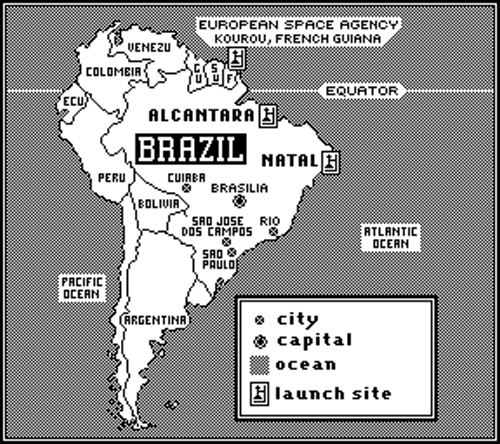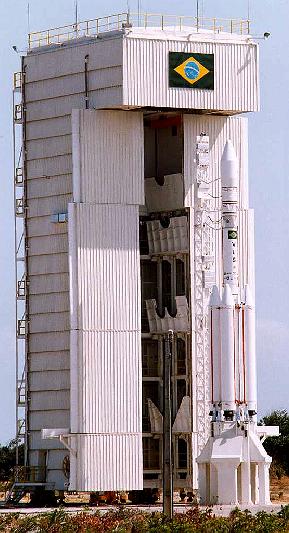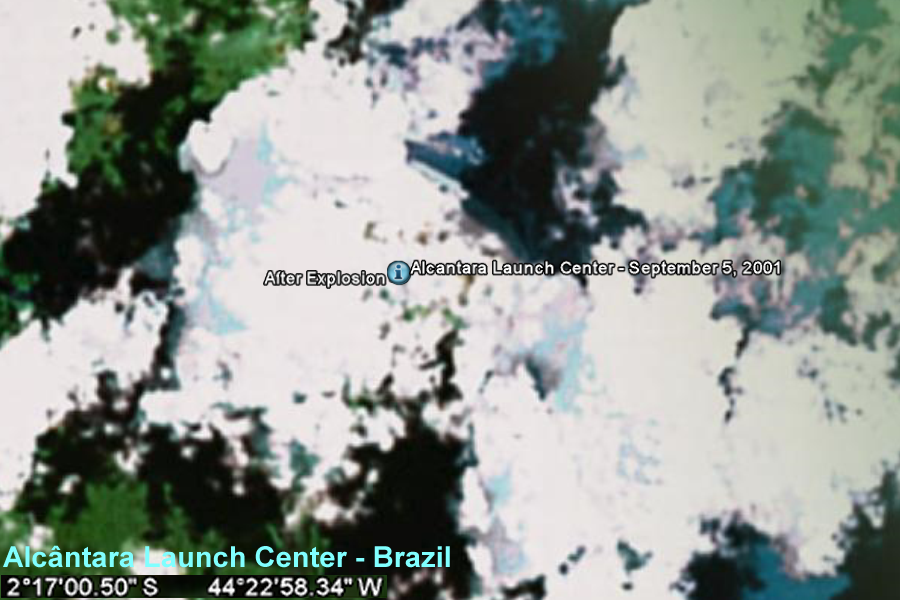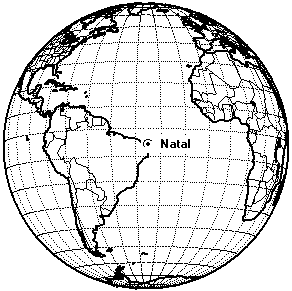|
|
|
|
..
Brazil's Ministry of Aeronautics has space launch and tracking facilities in northeast Brazil on the country's 4,603-mi.-long Atlantic Ocean coast near Alcantara and Natal, not far south of the equator. The European Space Agency space launch site is nearby on the Atlantic Coast at Kourou, French Guiana, north of the equator. VLS. The Alcantara Launch Center, Brazil's main site, is on the Atlantic coast outside of Sao Luis. Launch pads on the ground blast off Satellite Launch Vehicle or Veiculo Lancador de Satelites (VLS) space boosters, Sonda sounding rockets, meteorological rockets and other science boosters. Brazilian scientists have launched hundreds of sounding rockets since the mid-1960's. Alcantara, also known as CLA, has a launch control center and blockhouse. Its position nearer the equator is said to offer a launch advantage over Cape Canaveral. MECB. The Brazilian Complete Space Mission (MECB) has a control and tracking station at Cuiaba, Mato Grosso. Satellites transmit data down to an analysis station at Cuiaba for distribution across the country. Mission control is in Cachoeira Paulista in Sao Paulo. Development is at Instituto de Pesquisas Espacias (INPE) at San Jose dos Campos. Meanwhile, farther north, the nation's Brazilsat communications satellites have been launched by ESA from Kourou. Space Business. The Brazilian Space Agency (AEB) has plans to launch rockets and satellites from Alcantara for other nations, including the U.S., Russia and China. For instance, Ukraine signed an agreement in 2003 to blast off its small Cyclone-4 rockets from Alcantara. A U.S.-Russian space business venture headed by the U.S. firm Lockheed Martin might launch Russian Proton rockets from Alcantara. Looking for a launch site on the equator, the People's Republic of China has considered shipping Long March rockets to Brazil for launch from Alcantara. SOURCE: Space Today Brazil |
|
|
Alcântara Launch Center Brazil 2° 17' 00' S, 44° 23' 00' E ..
Veiculo Lancador de Satelites (VLS) at Alcantara Brazil's Difficult Road to Space Brazil's third attempt to launch satellites to space using its first family of Veiculo Lancador de Satelites (VLS) rockets exploded August 22, 2003. The launchpad explosion outside the equatorial city of Alcantara killed 21 engineers and technicians. Two satellites were destroyed. A successful launch of its VLS would have given Brazil the honor of being the first Latin American nation able to send its own satellites to orbit. Three Attempts
The launcher was three days from its scheduled trip to space when fire appeared around the four solid-fuel boosters at the bottom of the upright rocket. The VLS exploded on the launch pad. Intense heat during the explosion melted the large steel support gantry surrounding the rocket. That collapsed the entire launch pad, a major blow to Brazil's space program. The two small science satellites lost in the VLS-1 VO3 explosion had been developed by Brazil's National Space Research Institute. Jungle base. The seaside Alcantara spaceport is carved out of the jungle 150 miles south of the equator on Brazil's northeast coast. The base is in the state of Maranhao some 25 miles from the city of Sao Luiz and accessible only by plane, helicopter and boat. Rocket scientists say Alcantara is well placed for space launches because its proximity to the equator requires less fuel to loft a rocket to orbit. The Brazilian Space Agency (AEB) also has plans to launch rockets and satellites from Alcantara for other nations, including the U.S., Russia and China:
Russian President Vladimir Putin sent condolences to the Brazilian people. His nation had experienced the loss of many personnel in launch pad explosions – 90 in a blast in 1960 and 50 in an explosion in 1980. SOURCE: Space Today Rockets |
|
Related Links:
 |
|
|
Brazil 2° 17' 00' S, 44° 23' 00' E ..
|
|
|
Brazil 2° 17' 00' S, 44° 23' 00' E .. VLS satellite launcher at the Alcântara Launch Center Alcântara Launch Center
The Centro de Lançamento de Alcântara (English: Alcântara Launch Center; CLA) is a satellite launching base in the city of Alcântara, located on Brazil's northern Atlantic coast, in the state of Maranhão. Its geographical location [show location on an interactive map] 2°17′S 44°23′W / -2.283, -44.383. It is operated by the Brazilian Air Force (Comando da Aeronáutica). The CLA is the closest launching base to the equator. This gives the launch site a significant advantage in launching geosynchronous satellites, an attribute shared by the Guiana Space Centre. Construction of the base began in 1982. The first launch occurred on February 21, 1990, when the sounding rocket Sonda 2 XV-53 was launched. Also, the Ongoron I and Ongoron II rockets were tested here by the French Government in 1994. So far, only sounding rockets and VLS rockets have been launched from Alcântara. On August 22, 2003, the explosion of the third VLS-1 (VO3) killed 21 people. There are also plans to launch several international rockets from Alcântara. In 2003 contracts were signed to launch Ukrainian Tsyklon-4[2] and Israeli Shavit rockets; In addition there are further plans to launch the Russian Proton rocket and the Chinese Long March 4 . Current government plans to construct a civilian launching center, operated by the Brazilian Space Agency (Agencia Espacial Brasileira) and adjacent to the military controlled CLA, have stirred opposition among most of the villagers in the area, fearful of relocation to cramped agrovilas. These villagers are pursuing a legal right to their land as remanescentes das comunidades dos quilombos (escaped-slave descended communities). Brazil's 1988 constitution requires that the government award land rights to such communities. |
|
|
Brazil 2° 17' 00' S, 44° 23' 00' E ..
Natal Rocket Launch Site Did you know that Natal has a launch site for rockets? Well, it does… since 1965! The rockets are suborbital, so they don’t reach deep space like NASA rockets, but it’s still a very important place for research and development. This web page has a chronology of all the launches held at Natal. There are not many external Natal links on this page, but it’s worth taking a look at the exciting catalogue of rocket launches held here! SOURCE : Natal Info Type: Suborbital Launch Site
Sounding rocket launch location known to have been used for 233 launches from 1965 to 2007, reaching up to 1100 kilometers altitude. Launch Pads:
|
|
|
Other Space Ports:
|
|
| FAIR USE NOTICE: This page contains copyrighted material the use of which has not been specifically authorized by the copyright owner. Pegasus Research Consortium distributes this material without profit to those who have expressed a prior interest in receiving the included information for research and educational purposes. We believe this constitutes a fair use of any such copyrighted material as provided for in 17 U.S.C § 107. If you wish to use copyrighted material from this site for purposes of your own that go beyond fair use, you must obtain permission from the copyright owner. | |
|
|





